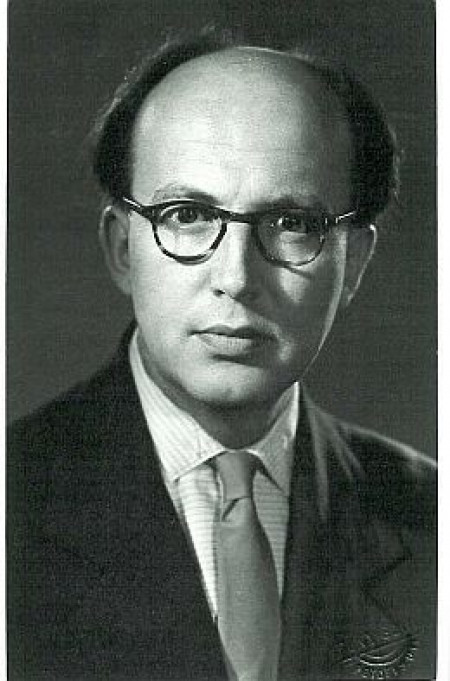
19 January 1917, Stachy – 2 August 1982, Budapest
At the age of sixty, on the occasion of his first "composer's evening", Rudolf Maros supplemented the programme notes with the following brief biographical details: "Born in 1917. Zoltán Kodály's pupil at the Music Academy. Studied with Alois Hába in Prague. Since 1958 has repeatedly participated in the lectures of the Darmstadt Ferienkurse. 1939-1942: viola player in the Budapest Municipal Orchestra; 1942-1949: teacher at the Pécs Municipal Music School; 1949-1977: teacher at the Music Academy." This laconic, almost self-ironically brief account provides data as regards Maros's composition studies and his teaching career, but makes no mention of the works which made him one of the most significant composers in the generation after Bartók and Kodály.
Maros was born in Stachy in Czechoslovakia. After graduating from the Győr conservatory, in 1939 he entered the Budapest Music Academy, where, besides having composition studies with Kodály, he learned viola playing from János Temesváry. During his Pécs period he played an all-purpose musical role in the town, teaching, conducting choir and orchestra, composing choir pieces, string works and music to accompany theatrical performances, as well as playing in a quartet. After 1945, he played a part in bringing Kodály's concept of music teaching to Pécs, as well as assisting Kodály in the orchestration of Cinka Panna. Many of his musical, literary and theatrical connections dated from Pécs, including his friendship with the poet, Sándor Weöres. He composed an early work, the Nyúlfark Cantata, and several songs to Weöres poems. On the composer's death, Weöres wrote a little poem commemorating his spirit. Maros retained his connection with Pécs even after moving to Budapest: Imre Eck's Pécs Ballet inspired him to write three pieces for the ensemble; the ballets were performed all over the world.
In the enclosed political and spiritual world of the post-1945 decade, Rudolf Maros followed the path set out by Kodály with complete naturalness; his horizons as a composer were widened only by his 1949 grant-assisted studies with Hába. Later on, as a mature composer with his own voice, he still considered himself to be a member of the Kodály school. "My early chamber pieces and String Symphonies were composed very much under the influence of the master. I have him to thank for the careful arrangement of the musical material and the development of a sense of form. Naturally, I followed Zoltán Kodály in the arrangement of folksongs as well, as, for example, in the Ecseri Lakodalmas (Ecser wedding feast music), which was performed by the State Folk Ensemble thousands of times." (1976) "The strict formal requirements are the greatest strength of the Kodály school, and it is this skill that protects the composer from being carried away by the ecstasy of his discoveries and from loosing his sense of proportion for the sake of certain effects." (1968) Rudolf Maros was protected from mistakes in proportion also by the inner harmony of his personality and his instinctive sense of style. While he was among the first Hungarian composers in the fifties to become open to the results of the music of the Viennese school, Webern and the serialists, he immediately selected and shaped the accumulating new knowledge. Thus his new-style music preserved sureness of taste, elegance of expression and economy of form – in that sense, with all the changes and transformations in style, his life's work is unified and harmonious.
In the first phase of his search for his own path, when, at the age of forty, he began to learn from the experiences of the Warsaw and Darmstadt festivals, he made use, besides the influence of Webern, that of Bartók as well (Ricercare 1959, Cinque studi 1960, Musica da ballo 1961). In the years to follow he came to find his own individual style through tone studies of particular beauty (three euphonies 1963, 1964, 1965). From the second half of the sixties, the magical tone production was complemented by a richer content, an organic inner dramaturgy, and melodic-rhythmic characterisation, creating a synthesis of modern and traditional elements (Gemma, 1968, Monumentum 1945 1969, Consort 1970, Landscapes /Tájképek/ 1974, Kaleidoszkóp 1976). In the two Sirató (Lament) (1963) he combined the new technique with the human voice, and in the Magyar Sirató (Hungarian Lament) (1969) produced a shattering reinterpretation of the ancient Hungarian folk style.
Rudolf Maros utilised the new results of Western music not only in his own workshop, but mediated it also for the multitude of his pupils and friends. At the Music Academy he taught, besides wind chamber music, music theory and orchestration, the techniques of twentieth century composition. His culture, open and honest demeanour, cheerful and tolerant personality made him widely liked, and he also carried out his work as a radio lector to general satisfaction. He was awarded the Erkel Prize three times, and was given the titles, Meritorious Artist and Outstanding Artist, in recognition of his work. He was a founding member, and a member of the presidium, of the Hungarian Musicians' Association, besides which, as a member of the presidium of the New Music International Society, he worthily represented Hungarian music abroad for decades. He died painfully early, at the age of sixty-six.
Márta Papp


